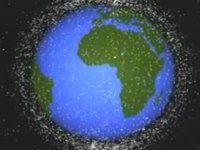Space debris to be removed from Earth's orbit
Kerry Nock of Global Aerospace Corporation stated that the problem of space debris is becoming increasingly more acute every year. He said that recently one of our orbiting satellites was put out of order, and may happen again. He suggested that once nothing can be done about the debris, we should at least try to reduce its amount by removing broken equipment from the orbit.
Now debris mean mainly fragments of various satellites that no longer serve any useful purpose, but may damage the operating units, and in some cases threaten nuclear or toxic contamination when they fall on Earth.
According to the report published in October of 2009 by the UN Office for Outer Space Affairs, approximately 300,000 such objects revolve around our planet. As for the total number of man-made orbiting objects, the combined weight of them may reach up to 5,000 tons, of which only about 10 percent (about 8,600 objects) are tracked by ground radar and optical means. However, only about 6 percent of the tracked objects are active, the others are not functional or used fragments of rockets and other equipment. Since most of these objects are in orbits whose planes intersect with each other, thanks to large accumulation of kinetic energy a collision of any of them with the existing spacecraft may damage it.

The amount of accumulated debris in orbit is so large that over time this can lead to Kessler effect. The contamination density will become so high that collisions between space debris objects will exponentially increase the amount of debris and new clashes. This will make it impossible to fly into space for years.
To date, there are no effective measures to protect against debris larger than 1 centimeter in diameter. The "Anti-debris" international space program is limited mainly to preventive monitoring of equipment debris near Earth.
However, not that long ago engineers at the University of Strathclyde in Glasgow developed a plan to save the planet from asteroids, based on innovative laser technology. A group of small satellites equipped with high-energy lasers powered by solar panels may be used for these purposes. It is assumed that the laser beam creates a momentum that will lead to a deviation from the original object's trajectory. The same technology could theoretically be used against space debris.
Kerry Nock proposed not to create "debris" situations, and simply take the affected satellite away from the orbit. One option is to use trusses with built-in power sources (solar panels can also go bad). This will create a flow of electrons in the conductive truss, interacting with the Earth's magnetic field and (or) solar wind, which will "push" broken satellite towards the earth's atmosphere. Once there, it will simply burn and will not add to the orbital dump. The disadvantage of this method is that the trusses will increase the cross sectional area of the device and, therefore, increase the risk of collision with operational satellites. It will be impossible to take a broken satellite from the orbit quickly using ropes.
The second option, which would be particularly effective for satellites "hanging" at low altitude, will be the use of ultrathin inflatable spheres for braking. They will be pumped with gas in advance, which will dramatically increase the resistance of the removed satellite. Eventually it will lower and again burn in the atmosphere.
This technology, says Kerry Nock, requires much less energy than the use of conductive wires interacting with the magnetic field of the Earth. However, use of ultra-thin brake elements is not possible in all cases. For example, it is not suitable for satellites in geostationary orbit, because at the height of 36,000 kilometers friction is near zero, and the unit may lower for a long time. However, so far the geostationary orbit is still not too littered.
Irina Shlionskaya
Pravda.Ru
Subscribe to Pravda.Ru Telegram channel, Facebook, RSS!


